Much of this information about Eastwood Chapel comes from a booklet published during the Second World war. The book is called Congregationalism at Eastwood, written by Herbert Wood. If anyone is particularly interested in the Chapel, a copy of the book can be seen at Todmorden Library.
Early non conformism
In about 1670, Oliver Heywood was holding meetings at Great House which the authorities repeatedly attempted to shut down. He was later imprisoned for his activities. After the 1689, the movement flourished and a room at great House was leased. In 1704 a group split away over the issue of infant baptism and founded a meeting house at Rodwell End. By 1719, the congregation had outgrown Great house and erected their first Chapel holding 200-300 people at Bent head (now called Chapel-houses).
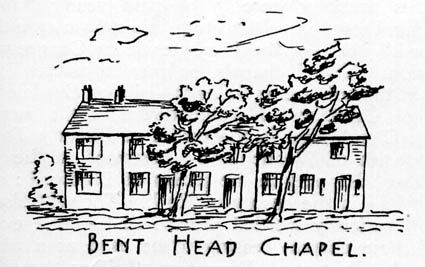
From the mid 18th century, the chapel went into decline due to the 'exceptional mortality in the district'. The congregation dropped to a handful of people.
Myrtle Grove
By the early 1800s, with the coming of industrialisation, the population was moving from the tops into the valley bottom. Discussions about moving the chapel began in about 1805 and local gentry settled endowments for the new chapel to be built. The new chapel opened in the summer of 1807 was called Myrtle Grove and stood on the site that later became Eastwood Railway station. It had a capacity of 500 people.

The chapel dissolved for a short period in 1817 due to a lot of rows between pastors and the congregation. The Deacon at this time was an Edmund Lord who worked as a weaver at one of the Rawden owned mills in Charlestown. The congregation again declined from about 1820. A minister's house was built in 1826, close to the Station House Hotel (this may have been at the end of the terrace in Duke Street). In 1838 the railway petitioned to include the site of the Chapel and it was purchased by the railway company in the following year.
A view of the Eastwood population at this time:
"It must not be imagined from what has been written so far, that the inhabitants of Eastwood were all upright and honest citizens. there were evildoers in those days as there are now, and laws against theft or damage to property were much more drastic. Tradition has it that representatives of the village were sent as convicts to Australia. Stealing was by no means uncommon and occasionally cloth was taken from the handlooms. Hand weaving persisted for a long time after the coming of the power loom, and the weavers sometimes took precautions against theft by tying the warp ends to their feet before retiring for the night......The less reputable amongst the population indulged in such sports as cock fighting, rabbit coursing, clog fights or wrestling for wagers. The Non Conformists on the other hand, still strongly under the influence of puritan tradition, looked askance at such pleasures and regarded them as enticements of the Devil".
The New Chapel
The new chapel opened in the summer of 1840.


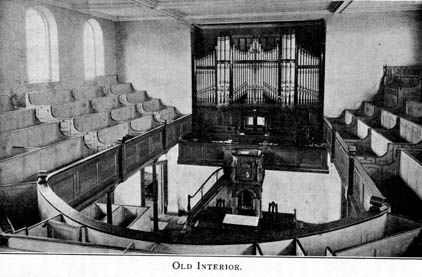
The services were accompanied by a twelve piece volunteer orchestra (strings, woodwind and sometimes a cornet) until in 1877 when an organ was installed. The first choir was started in 1887. The Chapel was refurbished in 1885 with new seats and gallery front.

You can see from the photo above that the chapel boasted a fine organ. In the 1920s, the bellows were pumped by a man called Abraham who lodged at Wood Bottom.
The First World War caused further friction in the congregation with the majority supporting the war. The minority pacifist group were often ostracised by the majority.
In about 1920 there was consternation in Eastwood when a young good looking minister called Mr Gibson joined the men in the corridor outside the Sunday School room and smoked a cigarette
The preparations for the centenary celebrations due to take place 1940 were rudely interrupted by the second World war.
Ministers during this period included a Mr Mills and lay preachers Mr Wilcock and Mr Arthur Greenwood (manager of Walsden Co-op). The last pastor was John Brightman who lived in the Manse up East Lee Lane. Ministers were known for their very lengthy (and boring to some!) sermons, but were greatly admired for visiting people in need.
Model of Eastwood Chapel
A few years ago one of the group was taking stuff to the tip at Eastwood and saw a small wooden model in a skip. She rescued it and later we discovered that it was of Eastwood Chapel. The three photos below show the level of detail on the model. Who made it, when or why, we don't know.
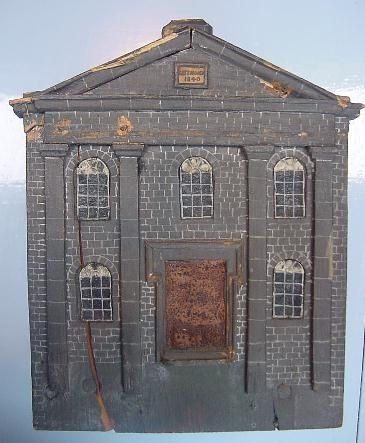

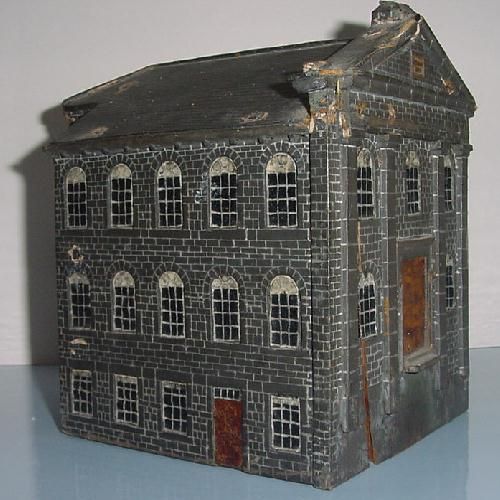
The Chapel was finally pulled down and a bungalow built on the site, but the graveyard still exists to this day (see archive page for photos and list of gravestones).
Eastwood Chapel was used for many community activities as well as a place of worship.
The Sunday School
The chapel at Myrtle Grove set up a Sunday school which was rebuilt as part of the new chapel.
Every year, on the 4th Sunday in May, the Sunday School anniversary was celebrated with old members who had moved away coming back for a reunion. The children occupied the front seats in the chapel gallery and sang hymns that they had practised for weeks beforehand. The choir was conducted by Ronald Sutcliffe. It was the day for new clothes.
Every year there was a Sunday School treat. In the 1920s and 30s this involved walking in procession to a farm on the hillside for games and sports (with prizes). Also memorable were the school buns and unbuttered currant bread with coffee.
Other groups meeting at the chapel
The chapel held evening meetings in the school area. One group was called Rosebud Juvenile Temple or The independent Order of Good Templars. These rosebuds met each week in the vestry with a president, vice president and treasurer, each of whom had regalias to wear. The group was given a talk, recited the pledge not to drink, smoke or swear and occasionally had games or competitions. Every winter, there was a coffee evening in the big room of the Sunday School - games in teams and circles and buns! An event of the year!
The older members' group was called Myrtle Grove Lodge and also preached that smoking and swearing was evil and that "strong drink is raging".
The local bank and friendly society
The kitchen in the chapel was used as a branch of the Yorkshire Penny Bank (which later became the Yorkshire Bank). At some time, it was run by Edgar wood who acted as the actuary. The Wood family were active in Chapel life. The sunday school ran a sick and funeral society which in 1881 had funds of £349 and 75 members.
Eastwood day school
After the 1870 Education Act the school Board set up a day school with the boys taught in the Sunday School premises and the girls 'looked after' in the vestry ("turning out some very good sewers and knitters").
In October 1927 there was a terrific downpour and the culvert at Cockden steps became choked by refuse which caused a flood on the main road. The water soon made its way down the steps and into the congregational school - the floor being covered to a depth of 18 inches. A concert which had been arranged for the saturday night by the Todmorden Co-op Society has to be transferred to Springside W.S.School.
Eastwood Players
The sunday school building was also use for entertainment with the Eastwood Players putting on regular performances as can been seen from the photos below.
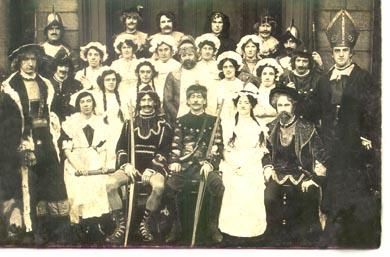
The performer on the far left is Harry Dawson, the bishop is Herbert Hartley. The photo was probably taken outside the main doors of the Chapel.
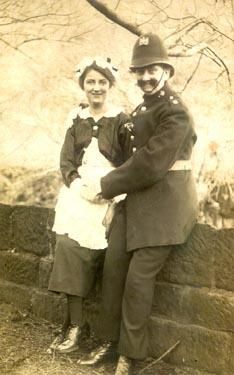
The performer on the left is Ethel Dawson (nee Barker).
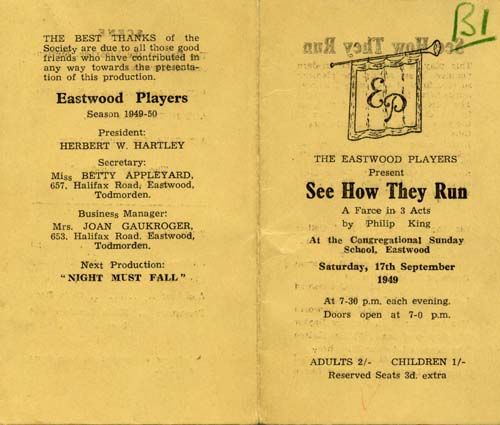
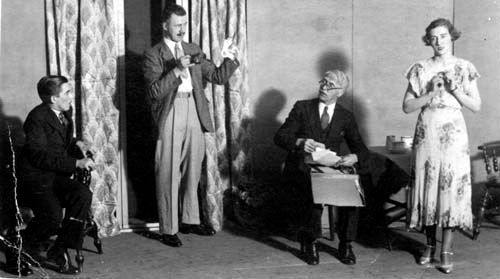
The performer on the right is Doris Sutcliffe (nee Stevens), The man standing is Percy Sutcliffe, her husband.
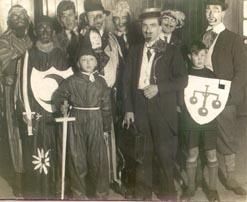
The performer in the middle, at the back and wearing what appears to be a mop head is Derek Barker Dawson and the guy 3rd from the left at the back is Maurice Hartley, who still lives in Eastwood.

See Archive page for further pictures of the players.
First World War Album
In 1920 Eastwood chapel Comforts Committee produced an album of photographs and short biographies of everyone from Eastwood who left home during the First world War. To see this fascinating document go to the First World War album page.
This page was last updated April 2009